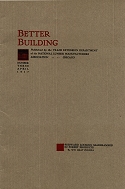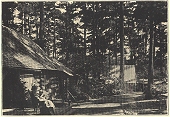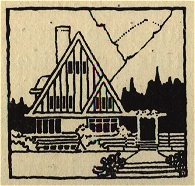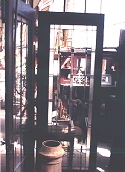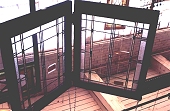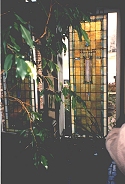|
|
|
Purcell and Elmslie, Architects Firm active :: 1907-1921
Minneapolis, Minnesota :: Chicago,
Illinois |
Ye Older Grindstones
9/29/2003
Cover, "Forward Looking Salesmanship in Forest Products" (1917)
Icon for the audience: Catherine Gray reading The Interior at Island Lake Camp, ca. 1890s (another end use of trees...)
Sketch
Sketch
Louis Heitman residenceSo Let It Be Written. Then as now, publicity is a double-edged sword in the practice of architecture. Photography alone is only one issue. There are bad photographs of great buildings that betray the higher reality into nonexistence, and good photographs of bad buildings frequently produce imposture of what is not actually present. Texts come in a variety of shades of good and evil, as well. Most architects like to think they are articulate about their work, but in the proof of publication few truly are able to speak cogently to an audience outside the peerage--and sometimes not even within the circle of their colleagues. Architectural writers who can manage both accessible insight and precision without lapsing into engineering jargon are generally far between, at least in my encounters with the literature.
The generic brethren cloistered at the AIA are not the sole offenders, either. For example, Louis Sullivan exasperated his fellow attendees at an architectural convention by reading his epic poetry in hopes of enlightening them. The report is that many rose and walked out, scratching their heads and muttering not necessarily to themselves. Claude Bragdon resorted to sometimes torturous mathematics and stylistic line drawings in an effort to evoke the basis of organic understanding in architecture, and he was one of those more available to the general public. A small number of dutiful laborers, such as Peter B. Wight and, to a lesser extent, Montgomery Schuyler, were able to cross the great divide and be legible to the laity--though that was not usually their intended audience. If any of these fine gentlemen (where are the ladies: Marion Mahony Griffin? Julia Morgan? Mary Jane Colter?) ever thought if it, the real issue in all of this is one Purcell mastered: advertising.
Aside from the earnest but preciously abstruse The Statics and Dynamics of Architecture published by P&E in 1912, most of the time Purcell (and Elmslie, when he is shown as co-author) went after the mind and heart of the average man (and woman). Purcell excelled at editorial challenges, unafraid to get out there into the mails with lengthy, sometimes nearly polemic lances raised against this or that article or public event (the American Renaissance articles resulting from The Outlook or the Lincoln Memorial controversy are only two examples). Yet, the fundamental eagerness to serve the Cause was sometimes stalled by a particular demand P&E often made whenever their own work was published: control, either direct or by leaning into the wind, of the graphical layout.
From an early effort to get the work of the firm published in Collier's through a fortuitous encounter by Purcell with editor Norman Hapgood (one which would have succeeded except for an unfortunate military event that displaced the pages), through newspaper interviews [e.g., Why a Greek Colonnade to Lincoln?' Ask American Architects," by Francis Fisher Dyer (1912)], and their own publications like The Western Architect issues (1913, 1915), P&E strove to present image and text as correlative elements of an organic whole--and the interstitial tissue was their placement of columns, illustrations, and captions. The system started out as some experiments by Purcell to redesign the cover art of his grandfather's old weekly The Interior (renamed The Continent in hopes of increasing circulation, but alas it was the pen of the deceased Dr. Gray that prospered the enterprise all those long years). At every opportunity WGP relentlessly insisted that the image of the text was at least as mighty as the sword, sometimes to the eventual relinquishment of interest by otherwise helpful publishers, and a special format germinated and matured.
Thus, at the end, the last publication by Purcell while the firm was still in business represents the outgrowth of nearly a decade of purposeful intention. And, of course, "Forward Looking Salesmanship in Forest Products" in the
Better Building series [National Lumber Manufacturers Association: Chicago, April, 1917 (#3)] was a pamphlet for a marketing mouthpiece which produced, then as now, really just an exalted bit of advertising effluvia ranked up into public service by a creditable aesthetic voice, namely Purcell. How WGP must have been galled to see captioned with his writing a Colonial revival Philadelphia church by Heacock and Hokanson with what was the only possible compliment: "The roof rejoices in shingles and the wood porch posts don't wish they were stone." Fortunately most of the illustrations were of P&E works in which wood was a primary building material (Paul Mueller Studio, Edna S. Purcell residence, Henry Einfeldt residence, and Francis Buzzell cabin).Based on an address given earlier by Purcell to the American Institute of Architects national convention in Minneapolis in 1916, the Message comes across loud and clear, as always. In the usual poetic way which would really peak into full efflorescence in the torrent of Northwest Architect articles from 1940 to 1955 (much like Elmslie's post P&E terra-cotta gets a bit seedy), the iconography starts out with a glimpse of Island Lake Camp and delivers to final burst of Walt Whitman. In a way this short essay written in an intimate, first person style is the most completely kitted-out of all those published by Purcell in the 1910s. There is even a little compromise, for even though the little booklet managed to fulfill the graphical yearning at long last, Purcell takes an occasionally, if only slightly, forgiving tone toward those in the profession and the trades who are well-intentioned toward architecture but ignorant of the real issues.
The same year this pamphlet was published Purcell realized he had stepped into deep corporate muck while serving as part-time advertising manager and company architect at Alexander Brothers Leather Belting Company during the World War I. He would wind up that involvement with a lawsuit and a flight westward to Oregon, where trees were still to be had aplenty (unlike the formerly virgin forest around Island Lake Camp, which had been felled by order of Stanley McCormick). P&E would linger on life support for a few months, but not survive the journey. The distance between Purcell in Minneapolis and Philadelphia and Elmslie in Chicago was hard enough; the West Coast was simply too far away, both literally and figuratively. This lovely little book, shill for a trade association that it was, turned out to be a fortuitous grace note to their mutual urge for being together in the first place.
COMING ATTRACTION: Scans of "Made in Minnesota," an article by Purcell that appeared in The Minnesotan magazine (April 1916), a monthly published by Minnesota State Art Commission. Written at the same time as the address that later became the Better Building text, this essay is also a stab at converting the natives to proper use of building materials.
9/16/2003
Unidentified leaded glass panel
Unidentified panel
Check desk fixture
Madison State Bank
Two clerestory panels from the Madison bankLet there be light. Cranking up the queue, some old photographs obliged with their immediate presence. A few years ago a friend sent me several pictures of as-yet unidentified P&E leaded glass panels that washed up in an architectural antiques store in Minneapolis. I didn't get to see them in person, and they are long gone to the home of someone hopefully more respectful of fine art than the unknown unfortunates who cast them adrift from their original moorings. Light in salvage stores is almost always industrial grade, so these images are dark (also thanks in part to a cheap scanner; the originals have better color).
Many bits and pieces of P&E are tethered here and there, some more tenuously than others. Fragments of the Madison State Bank, including portions of the main skylight, can be found installed in a country bar in northern Minnesota. A collector who prefers anonymity holds light fixtures from the Madison bank and all the remaining clerestory window panels. I was told that at least one of the great panels disintegrated while being dislodged during demolition. The cypress doors from the Decker house remain in service at another house on the shores of Lake Minnetonka, as do several leaded glass panels, though my photos seem to be in hiding at the moment. One soul trying to capitalize on some Decker fragments sent them to New York in the early 1990s with a $2000 per panel reserve that didn't get met. Presumably they yet survive somewhere in Minnesota, but that is uncertain. Then, at the end, fragments get scooped up institutionally from time to time. The Minneapolis Institute of Art (Click on the link and search under "Elmslie") recently accessioned a number of fragments from the estate of David Gebhard, some of which can be seen through their on-line catalog system.
COMING ATTRACTION: Scans of "Better Building," a pamphlet published by the Trade Extension Department of the National Lumber Manufacturers Association (#3, April 1917), featuring "Forward Looking Salesmanship in Forest Products" written by Purcell and illustrated with images of P&E as well as an iconic view of Island Lake Camp.
9/8/2003
Me driving the prop cop carCrew and camera, inside and out To leave is to return. Back at last. For anyone who has not ventured into the realm of film making it can be hard to credit the sheer consumption of being the activity represents. You have no life. You have a job, only. Working from 7 am to 10 pm, 6 days a week--and, coincidentally, in the brutal, relentless 110+ degree heat of the San Fernando Valley location--the level of energy required to participate (assuming you are actually DOING your job, and there were some on set who weren't) is extraordinary to maintain consistently. In 50 years on this earth, nothing I have ever done required so much stamina, effort, and creativity. Gives meaning to the phrase "Slaves can't be fired. They have to be sold." Obviously, despite my best intentions, there was no time to put up a production web site at the time. The wrap party is this coming Saturday, and I mean to have it up by then.
Last night I dreamed I was in a large P&E mansion, if you could ever use that term to describe one of their country houses. The place was vast, and filled with terracotta, leaded glass, sawed wood, and fine textiles. I wonder where my mind, at whatever level those images arose, got those designs; they weren't any I've actually seen. Halfway through the dream I realized I was dreaming BECAUSE I couldn't tell which house I was in (go figure). I opened panels with hidden latches, looked through windows long shut, and found doors and passageways not readily visible. Finally I came around a corner to a vestibule and saw a magnificent tapestry alive with Elmslie-style patterns being cleaned and hung by an elderly woman. Beyond her was a great staircase, up to a higher floor, with a swan shaped newel post. And so, this morning, I pick up the Work again.
Finally, a note. Strange to be in a town where highly talented people can go for years without getting a decent job in the biz and suddenly find my newbie self a production designer for feature films. A second film has already been greenlighted, with pre-production to start after the first of the year. And there is immediate talk of a third, with a massive budget, requiring a year of research. We'll see, for in Hollywood it's only talk until the check has cleared. Like architecture--with which movies have a very great deal in common--the best way to get work is to have work.
8/1/2003
There will be no updates to this site until Labor Day weekend, as I am now in full thrust on production design for the film. I am setting up a web site for that once shooting starts, and I will post a link here for those who are curious. In fact, it'll be interesting to see if people notice the few P&E/Progressive elements that I am sneaking into the background. Hey, it's supposed to be fun--even if it can be frustrating!

